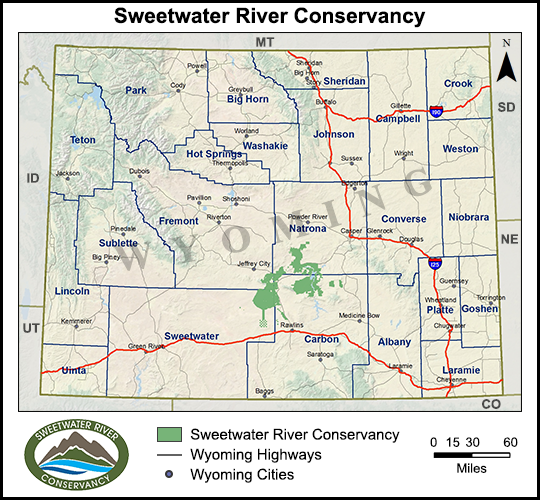Regulatory | NGI All News Access
First Sage Grouse Conservation Bank Created in Wyoming
The nation’s largest conservation bank — and a first for greater sage grouse — has been established in central Wyoming to provide credits that would allow energy development in other parts of the state.

The heart of the project, created by the U.S. Fish and Wildlife Service (FWS), the Department of the Interior and the Sweetwater River Conservancy (SRC), consists of the 235,000-acre Pathfinder Ranch, a cattle ranch west of Casper near Pathfinder Reservoir that provides wildlife habitat for grouse and other native species. Close to 55,000 acres are set aside that contain a “robust” grouse population, with most of the bank classified as a sage grouse core area by the state.
As demand for the bank grows, it could expand to 700,000 acres on other lands managed and owned by the SRC.
“The long-term health of the greater sage grouse throughout the West depends on strong and innovative partnerships to conserve and restore its habitat in ways that embrace traditional uses of the land, such as cattle ranching,” Interior Secretary Sally Jewell said. “As the first conservation bank for greater sage grouse, the Sweetwater River Conservancy provides one model for how we can work with states, landowners, tribes, local communities and others to conserve our working, western landscapes.”
A conservation bank is a site or suite of sites established under an agreement with the FWS to protect, and where feasible, improve habitat for species. Entities can purchase “credits” that result from perpetual conservation easements and conservation projects on the land to offset impacts occurring elsewhere.
Originally purchased for wind energy development, the Pathfinder project was converted to a conservation bank and deeded to the newly created SRC with the encouragement of former Democratic Gov. Dave Freudenthal, who was in the process of building Wyoming’s core area sage grouse strategy.
The bank would manage not only sage grouse, but also mule deer and other wildlife, to allow energy development and other economic activities to proceed on lands elsewhere in Wyoming.
Wyoming is demonstrating that “energy, the environment and the economy working together can complement each other,” Republican Gov. Matt Mead said. “Private landowners, industry and conservationists along with state and federal agencies have worked together on this innovative conservation plan. It conserves habitat while facilitating oil and gas, mining and other economic drivers in Wyoming.”
Five years ago the FWS determined that the greater sage grouse warranted protection under the Endangered Species Act (ESA), but it was “precluded by higher priorities,” officials said. “Since then, a remarkable, broad-based coalition of different disciplines has come together across the bird’s 165 million-acre, 11-state range to address threats and prevent the need for a listing. Market-based mitigation tools, for example, conservation banks — and the financial incentives they provide — are valuable for conserving the habitat required for abundant, well-distributed sage grouse populations.”
For the effort to work, the Bureau of Land Management, U.S. Forest Service and other land managers “must be a full partner allowing the credits to be used and establishing clear guidelines for projects to proceed,” said the governor. “Using credits as an offset paves the way for effective management of sage grouse and other species.”
Last December the FWS said it was shifting from data collection to data analysis as it proceeded toward a Sept. 30 decision about whether the greater sage grouse still deserves protection under the ESA (see Daily GPI, Dec. 30, 2011). To ensure that the FWS had the best available information, officials were asked to submit documentation pertaining to the many conservation efforts that had been completed or were under way to benefit the species.
The Western Governors’ Association, of which Mead is a member, in January asked the Department of Interior for clarification about efforts to protect the bird (see Daily GPI, Jan. 20). The seven governors sought Jewell’s thoughts about when a final ESA decision regarding the grouse may be made. A budget bill signed by President Obama in December prohibits FWS from writing or issuing a rule to list the bird as threatened or endangered.
Jewell has indicated in recent months that state-federal measures may be enough to avoid a listing (see Daily GPI, Dec. 12, 2014).
Last month the U.S. Department of Agriculture (USDA) reported that since 2010 its partners in the Sage Grouse Initiative have worked with private landowners to restore 4.4 million acres of habitat while maintaining working landscapes across the West.
“American ranchers are working with us to help sage grouse because they know they are helping an at-risk bird while also improving the food available for their livestock,” said Under Secretary for Natural Resources and Environment Robert Bonnie. “As the saying goes, ‘What’s good for the bird is good for the herd.'” USDA also said it would commit another $200 million to sage grouse conservation work over the next four years.
© 2024 Natural Gas Intelligence. All rights reserved.
ISSN © 1532-1231 | ISSN © 2577-9877 |
